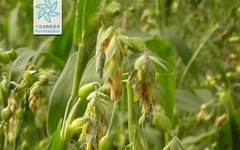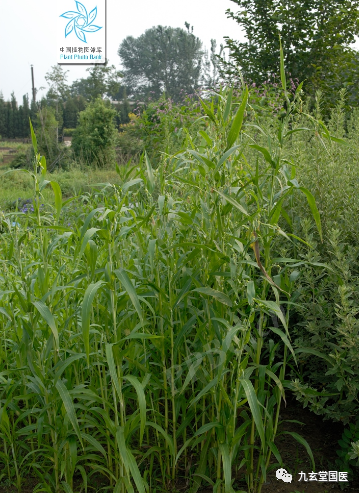
Alias:Jie Li, Qi Ying, Gan Mi, Gan Mi, Yi Zhu Zi, Hui Hui Mi, Cao Zhu Er, Gan Zhu, Yi Mi, Mi Ren, Yi Ren, Yi Ren, Yu Ma, Liu Gu Mi, Zhu Zhu Mi, Yao Yu Mi, Shui Yu Mi, Gou Zi Mi, Yu Mi, Yi Mi
Historical Sources:Grown in Zhen Ding Ping Ze and fields, produced in Jiaozhi; Liang Han.
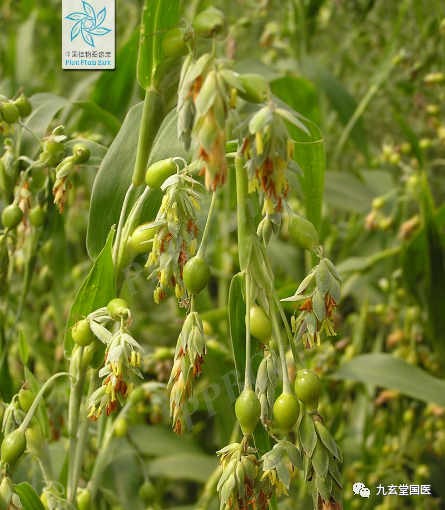
Source of Medicinal Material:This product is the dried mature seeds of the plant Coix lacryma-jobi. The plants are harvested in autumn when the fruits are ripe, dried, and the fruits are threshed, then dried again, removing the outer shell, yellow-brown seed coat, and impurities to collect the seeds.
Original Form:Coix (“Ben Jing”), also known as Gan (“Shuo Wen”), Wu Tan (“Bie Lu”), Yu Shu (“Yang Shi Jing Yan Fang”), Cao Pu Ti (“Cao Mu Bian Fang”), Yi Shu, Gui Zhu Shu, Niao Tang Cao, Tie Yu Shu Mu, Xia Yan Zi Shu, Gui Zhu Shu, Bian Po Ju.
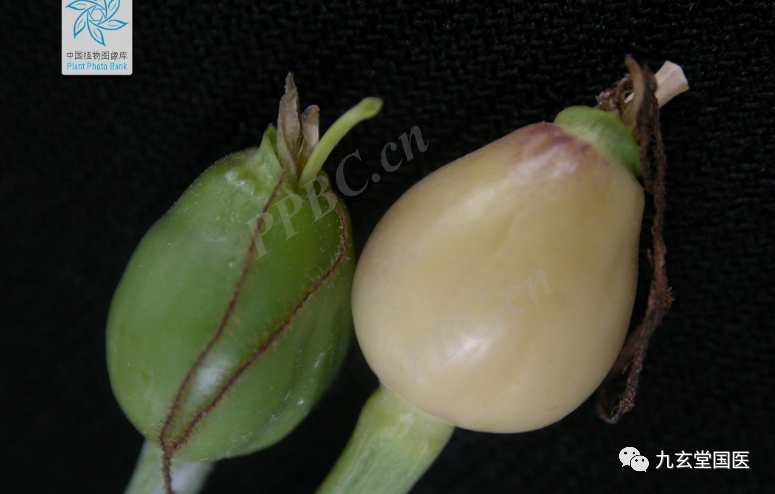
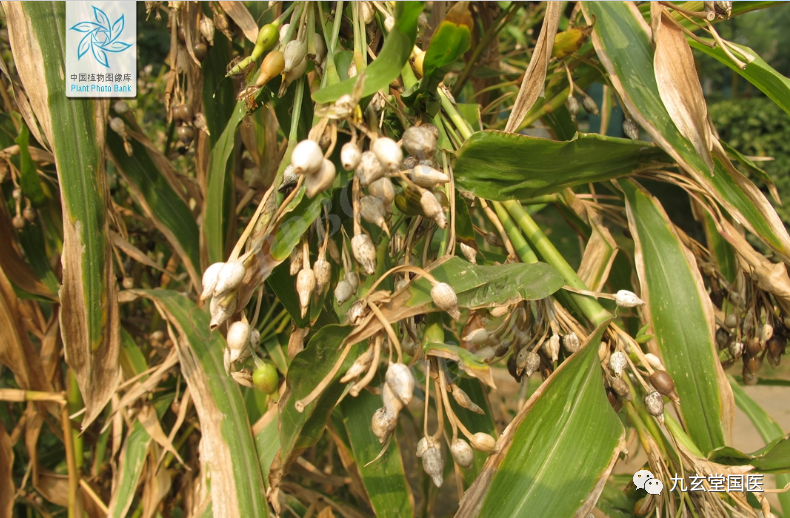
It is an annual or perennial herb. The fibrous roots are relatively thick, with a diameter of up to 3 mm. The stem is erect, 1 to 1.5 meters high, with about 10 nodes. The leaves are linear-lanceolate, up to 30 cm long and 1.5 to 3 cm wide, with rough edges, a thick midrib that is raised on the back; the leaf sheath is smooth, with the upper part shorter than the internodes; the leaf tongue is hard, about 1 mm long. The racemose inflorescence is axillary; the female spikelet is located at the lower part of the inflorescence, surrounded by a hard, bead-like glume, which is about the same length as the spikelet; the fertile spikelet has a membranous lower lemma, a thick paper-like upper lemma, and a blunt tip; the second lemma is boat-shaped, enclosed within the first lemma, with a thick paper-like tip that tapers; the second outer glume is shorter than the first outer glume; the inner glume is similar to the outer glume but smaller, with 3 stamens that are degenerated; the pistil has a long style; the sterile spikelet degenerates into a long cylindrical lemma. The male spikelets are often 2 to 3 per node; the stalkless male spikelet has a flat first lemma, with both sides folded inward to form a ridge with uneven wings, a blunt tip, and many veins; the second lemma is boat-shaped, also with many veins; both the outer and inner glumes are membranous; there are 3 stamens; the stalked male spikelet is similar to the stalkless one but smaller or more degenerated. The lemma fruit is enclosed in a hard glume, oval or oval-shaped. The flowering period is from July to September. The fruiting period is from September to October.
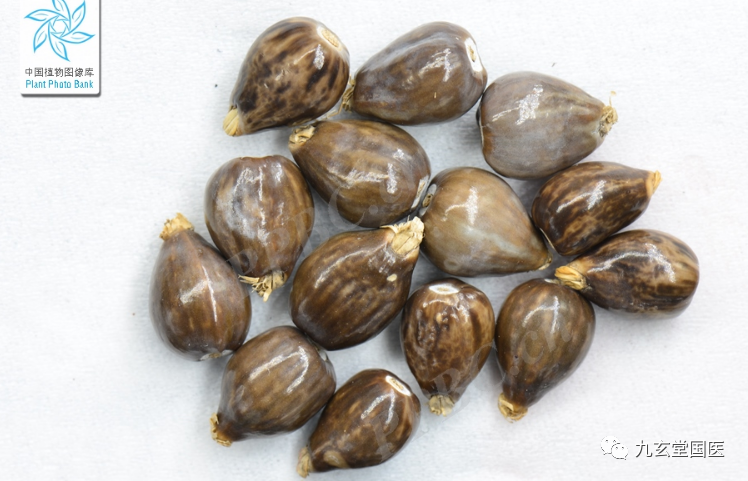
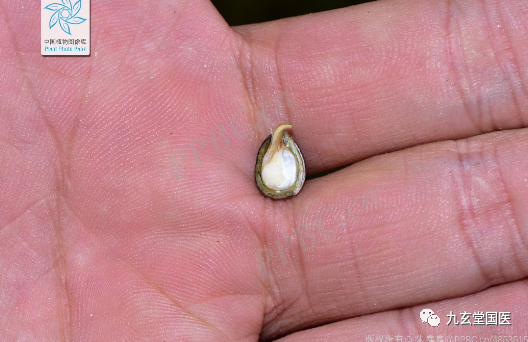
The roots (Coix root), leaves (Coix leaves) of this plant are also used medicinally.
Habitat Distribution:Commonly found near houses, in wastelands, by rivers, streams, or in damp valleys. It is distributed in most parts of the country, generally cultivated.
Resource Distribution:Produced in most regions of China, mainly in Fujian, Hebei, and Liaoning.
Harvesting:Harvest the plants in late autumn when the fruits are ripe, dry them, thresh the fruits, remove the outer shell, and collect the seeds.
Cultivation:Key points for cultivation: It prefers a warm and humid climate, is drought-sensitive, and tolerant of fertility. It can be planted in various types of soil, is relatively tolerant of salinity and moisture in saline-alkali and marshy areas, but is best cultivated in sunny, fertile loam or clay loam. It should not be planted continuously and is not suitable for crop rotation with other Gramineae. In recent years, it has been cultivated in moist rice fields, especially with shallow water during the heading and flowering period, which can significantly increase yield.
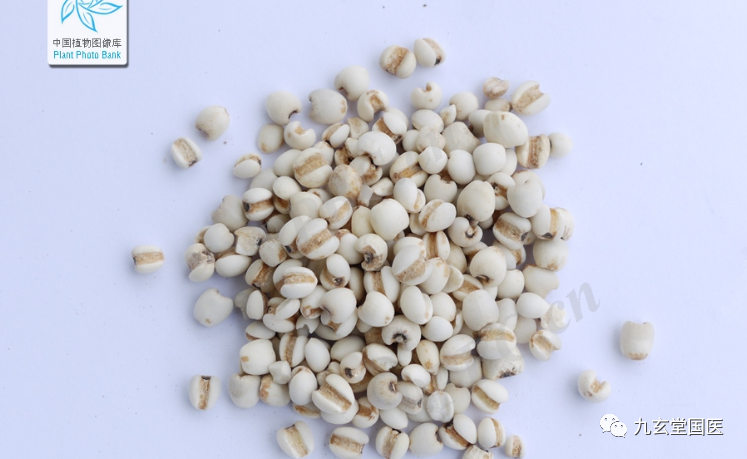
Identification of Characteristics:The dried seeds are round or oval-shaped, with a wider and slightly flat base, a blunt round tip, 5 to 7 mm long, and about 3 to 5 mm wide. The surface is white or yellowish-white, smooth or with indistinct longitudinal stripes, sometimes retaining a yellow-brown outer skin, with one deep and wide longitudinal groove on the side, the bottom of the groove is rough and brown, and the base is concave, with a small brown dot inside. The texture is hard, and when broken, the inside is white and powdery. It has a slight odor and a sweet, bland taste. The best quality is characterized by large, plump, white, and intact seeds.
Pharmacological Effects:Early reports indicated that oil extracted from Coix seeds using petroleum ether has a stimulating effect on frog striated muscle and motor nerve endings at low concentrations, while at high concentrations, it has a paralyzing effect. It has an inhibitory effect on striated muscle.
Processing:Coix seeds: Remove impurities.
Fried Coix seeds: Take cleaned Coix seeds and fry them in a pan over low heat until slightly yellow, then remove and cool. Alternatively, they can be fried with bran (100 jin of Coix seeds with 10 jin of bran).
“Lei Gong’s Theory of Processing”: “For every one liang of Coix seeds, use two liang of glutinous rice to cook together until the glutinous rice is cooked, remove the glutinous rice, and use the Coix seeds. If boiled with salty soup, it is a different method of processing, which is also acceptable.”
Taste and Properties:Spleen, Lung, Kidney meridians
1“Ben Jing”: “Sweet taste, slightly cold.”
2“Bie Lu”: “Non-toxic.”
3“Shi Liao Ben Cao”: “Neutral in nature.”
4“Ben Cao Zheng”: “Sweet and bland, slightly cool.”
Meridian Entry:Enters the Spleen, Lung, and Kidney meridians.
①“Gang Mu”: “Yangming.”
②”Lei Gong’s Theory of Medicinal Properties”: “Enters the Lung, Spleen, Liver, Stomach, and Large Intestine.”
③”Ben Cao Xin Bian”: “Enters the Spleen and Kidney meridians.”
Functions and Indications:Promotes diuresis, strengthens the spleen, relaxes tendons, eliminates dampness, clears heat, and drains pus. Indicated for edema, beriberi, dysuria, damp-heat diseases, diarrhea, leukorrhea, rheumatic pain, muscle spasms, lung abscess, intestinal abscess, and flat warts.
Dosage:Internal use: Decoction, 10-30g; or in pills, powders, soaked in wine, cooked in porridge, or made into soup.
Precautions:Use with caution in cases of spleen deficiency with constipation and in pregnant women.
①”Ben Cao Jing Shu”: “For those with dry stools, short urination due to cold causing spasms, and spleen deficiency without dampness, it is contraindicated. Prohibited during pregnancy.”
②”Ben Cao Tong Xuan”: “For those with diarrhea and sinking due to deficiency, it is not suitable.”
Various Discussions:
①“Ben Cao Yan Yi”: “Coix seeds, as stated in ‘Ben Jing’, are slightly cold and are indicated for muscle spasms. There are two types of spasms: as noted in ‘Su Wen’, if the large muscle is heated, it contracts and shortens, causing spasms due to heat, thus Coix seeds can be used; if ‘Su Wen’ states that spasms are due to cold, this should not be used. When using it, it should be doubled compared to other herbs. This herb has a gentle effect, and it must be used in larger quantities to see results. Cold can cause muscle spasms, while heat can cause muscle contractions; if only heat is present without cold, it can also relax muscles, and dampness can lead to weakness.”
②”Gang Mu”: “Coix seeds are Yangming herbs, capable of strengthening the spleen and benefiting the stomach. If deficient, it supplements its mother, thus used for lung atrophy and lung abscess. For diseases of the muscles and bones, treating Yangming is fundamental, thus used for muscle spasms and rheumatic pain. The earth can overcome water and eliminate dampness, thus used for diarrhea and edema. According to ancient prescriptions, in cases of stroke with muscle spasms, slow speech, and wiry pulse, add Coix seeds, which also supports the spleen and suppresses the liver. Additionally, ‘Hou Han Shu’ states that Ma Yuan in Jiaozhi once consumed Coix seeds, claiming it lightened his body and reduced desire, helping him overcome miasma. Zhang Shizheng’s ‘Jian You Lu’ mentions that Xin Jiaxuan suddenly suffered from a hernia, heavy as a cup, and a person advised him to use Coix seeds fried with yellow on the east wall, boiled into a paste, and after several doses, it disappeared. Cheng Shasui had this illness, and Jiaxuan taught him, and it was also effective. ‘Ben Cao’ states that Coix is a top-grade heart-nourishing herb, hence it has this effect.”
③”Ben Dan Jing Shu”: “Coix seeds are dry and can eliminate dampness, sweet in taste and can enter the spleen to nourish it, and can also drain and eliminate, thus indicated for muscle spasms and rheumatic pain, eliminating muscle and bone evil qi, benefiting the intestines and stomach, reducing edema, and allowing one to eat. In summary, when damp evil is eliminated, the spleen and stomach are settled, and when the spleen and stomach are settled, the middle burner is treated, and when the middle burner is treated, it can nourish the four limbs and promote blood circulation. Sweetness benefits the spleen, dryness eliminates dampness, and when the spleen is full, swelling disappears; when the spleen is strong, one can eat, thus the above diseases will heal without seeking treatment.”
④”Ben Cao Zheng”: “Coix has a sweet and bland taste, slightly cool, and a slightly descending and draining nature, thus can eliminate dampness and promote urination. Because it eliminates dampness, it can benefit the joints, eliminate beriberi, treat weakness and spasms, reduce edema and pain, promote urination for heat dysuria, and also kill roundworms. Due to its slight descending nature, it can also treat cough with purulent sputum, benefit the stomach, and due to its cool nature, it can clear heat, stop thirst, and relieve shortness of breath. However, its effect is very gentle, and it is advisable to use it as an assistant herb in larger quantities.”
⑤”Yao Pin Hua Yi”: “Coix, with a sweet taste and harmonious qi, can clear the turbid and nourish the spleen yin, greatly benefiting the intestines and stomach. It is indicated for spleen deficiency diarrhea, leading to edema, rheumatic muscle weakness, causing inability to bend and stretch. This is because excess dampness leads to seven defeats, and the earth overcomes the water to restore qi, thus swelling naturally disappears and strength is restored. It enters the lung, nourishes the source, and is used to treat upper burner thirst, lung abscess, and intestinal abscess. It also takes its thick and heavy taste to nourish the lower part, treating beriberi swelling and intestinal bleeding. If there is coughing blood for a long time and little food intake, it can be used to harmonize qi and gently restore strength, and doubling the dosage will yield results.”
⑥”Ben Cao Shu”: “Coix seeds eliminate dampness but are not as drying as other herbs, clear heat but do not damage yin like herbs such as Huang Qin and Lian, benefit qi but do not nourish damp heat like ginseng and atractylodes, making it an essential herb for benefiting the middle qi. However, its taste is bland, and its effect is gentle; if not combined with other herbs to assist, it may not achieve the desired effect.”
⑦”Ben Cao Xin Bian”: “Coix seeds are best for promoting urination without damaging true yin. For any dampness in the lower body, it is most suitable. Depending on the severity of the illness, adjust the dosage of the herbs, thus yin and yang are not harmed, and damp diseases are easily resolved. Therefore, for any water-damp symptoms, use one or two liang of Coix seeds as the main herb, and assist with herbs that strengthen the spleen and eliminate dampness, and there has never been a case where it did not work quickly. If the effect is diluted by its bland taste and used lightly, it will be of no benefit.”
⑧”Ben Jing Shu Zheng”: “Scholars say that benefiting qi, eliminating dampness, harmonizing the middle, and strengthening the spleen, Coix is somewhat similar to atractylodes, but they do not realize the subtle differences that can lead to significant errors. For qi, Coix is warm and slightly cold. For taste, atractylodes is sweet and pungent, while Coix is sweet and bland. Moreover, atractylodes has a thick qi and taste, while Coix has a thin qi and taste, which are completely different. This principle is evident in ‘Jin Kui Yao Lue’ – for those with body pain and discomfort, it is advisable to use Ma Huang and add atractylodes to induce sweating, and be cautious not to attack with heat. For those with full body pain and fever that worsens in the afternoon, this is called wind-dampness, and this illness is caused by sweating in the wind or prolonged exposure to cold, thus it can be treated with Ma Huang, apricot kernel, Coix, and licorice soup. Body pain indicates dampness combined with cold; full body pain indicates dampness combined with wind. Cold transforms from yin, while wind transforms from yang. Therefore, body pain indicates a solar condition; fever that worsens in the afternoon indicates a yangming condition. The solar condition should induce sweating, while the yangming condition should clear heat. Inducing sweating is to release the yang evil, while clearing heat is to suppress the yang evil. The quality of using atractylodes is for inducing sweating, while Coix is for clearing heat. However, Coix treats both wind-dampness and muscle spasms, which cannot bend or stretch. The combination of wind-dampness causes joint pain and discomfort, preventing bending and stretching. Why not use Coix? This is indeed a valid point; Coix is for treating chronic wind-dampness, not for treating acute wind-dampness. However, the Ma Huang, apricot kernel, Coix, and licorice soup formula is not for acute illness, is it? It is clear that the symptoms of sweating in the wind and prolonged exposure to cold are the causes, thus it seems like an acute illness, but it is not. The fever that worsens in the afternoon indicates that wind and dampness are about to transform into heat, thus Coix is combined with Ma Huang, apricot kernel, and licorice to meet the condition and seize the opportunity to eliminate it. The combination of wind and dampness causes pain and discomfort, preventing self-rotation and side movement; thus, it is necessary to use Coix.”
Compatibility:
1.“Wen Bing Tiao Bian”: Coix seeds, white cardamom, apricot kernel, bamboo leaves, Tong Cao, talc, Ban Xia, Hou Po. Treats warm diseases with symptoms of headache, chills, body heaviness and pain, white tongue coating, no thirst, chest tightness, and lack of appetite, with afternoon fever.
2.“He Ji Ju Fang”: Combined with ginseng, poria, and white atractylodes, such as in Shen Ling Bai Zhu San, which can drain and eliminate spleen dampness, strengthen the spleen, and stop diarrhea.
3.“Qian Jin Fang”: Combined with reed stem, winter melon seeds, and peach kernels, such as in Wei Jing Tang, which can treat lung abscess, chest pain, and cough with purulent sputum.
4. For edema, beriberi, and dysuria: This product is sweet and nourishing, with a weak effect compared to poria, capable of promoting urination and eliminating dampness, as well as strengthening the spleen and harmonizing the middle. It is used to treat edema, abdominal distension, beriberi, and dysuria caused by spleen deficiency and dampness obstruction, often combined with poria, white atractylodes, and astragalus to enhance its effects of strengthening the spleen, supplementing the middle, and promoting urination and eliminating dampness. Additionally, due to its cold nature, it can clear heat and eliminate dampness, thus it can be used for damp-heat accumulation, short and red urination, often combined with talc, poria, and winter melon peel, or used alone to treat damp-heat dysuria.
5.For spleen deficiency diarrhea: This product can both supplement the spleen and benefit qi, as well as promote urination and eliminate dampness, thus it can be used for diarrhea due to spleen deficiency and damp stagnation, requiring fried Coix seeds combined with Chinese yam, white atractylodes, and poria.
6.For rheumatic pain and limb spasms: This product can eliminate dampness and relieve pain, relax tendons, and ease spasms, thus used for damp stagnation in the muscle and meridians causing rheumatic pain and spasms. For those with rheumatic heat pain, combine with Ma Huang and apricot kernel; for those with damp stagnation in the muscle and meridians with body heat and pain, combine with bamboo leaves and gypsum; for those with wind-damp cold pain, beriberi, and limb spasms, frequently consume porridge made with glutinous rice; for those with initial damp-heat or summer dampness in the qi level, with chills and body heaviness, and limb soreness, combine with talc and cardamom; for those with damp-heat pain, combine with talc and forsythia.
7.For lung abscess and intestinal abscess: This product clears lung heat and drains dampness from the intestines, capable of draining pus and eliminating abscesses, used for lung abscess and intestinal abscess, for lung abscess with chest abscess and cough with purulent sputum, combine with winter melon seeds and peach kernels; for intestinal abscess with abdominal pain, combine with herb of Baijiao and Dan Pi.
Additional Formulas::
①For those with full body pain, fever, and worsening in the afternoon, known as wind-dampness, this illness is caused by sweating in the wind or prolonged exposure to cold: Ma Huang (remove joints) half a liang (soaked in soup), licorice one liang (roasted), Coix seeds half a liang, apricot kernels ten (remove skin and tip, fry). Grind into a powder, each dose four qian, with one and a half cups of water, boil to eight parts, remove the dregs and take warm, avoiding wind. (“Jin Kui Yao Lue” Ma Huang, Apricot Kernel, Coix, and Licorice Soup)
②For rheumatic pain and weakness in limbs, and soreness in the waist and spine: One jin of Coix seeds, four liang each of real mulberry, angelica, Sichuan ligusticum, and Cang Shui (soaked in rice wash and fried). Divide into sixteen doses, boil in water and take. (“Guang Ji Fang”)
③For chronic rheumatic pain, supplementing qi, benefiting the intestines and stomach, eliminating edema, and removing evil qi from the chest: Grind Coix seeds into powder, cook with glutinous rice porridge, and eat daily. (“Gang Mu” Coix Seed Porridge)
④To eliminate wind-dampness, strengthen muscles and bones, and benefit the spleen and stomach: Coix seed powder, brew with glutinous rice to make wine, or brew in a bag and drink. (“Gang Mu” Coix Seed Wine)
⑤For edema and dyspnea: Two liang of Yuli Ren. Grind, filter with water, and boil with Coix seed rice, eat twice daily. (“Du Xing Fang”)
⑥For lung atrophy with purulent blood: Ten liang of Coix seeds. Crush, with three sheng of water, boil to one sheng, add a little wine and take. (“Mei Shi Ji Yan Fang”)
⑦For lung abscess with cough and sputum, and chest discomfort: Boil Coix seeds in strong bitter wine until concentrated, take warm. If there is blood in the lungs, it should be expelled. (“Fan Wang Fang”)
⑧For lung abscess with coughing blood: Three taels of Coix seeds. Mash, with two large cups of water, add a little wine, divide into two doses. (“Ji Sheng Fang”)
⑨For intestinal abscess, with full body discomfort, abdominal skin tight, pressing feels like swelling, no accumulation in the abdomen, no fever, pulse rapid, indicating pus in the intestines: Ten parts of Coix seeds, two parts of Fuzi, and five parts of Baijiao. Grind these three ingredients into powder, take a spoonful, with two sheng of water, boil down to half, take warm, urination should follow. (“Jin Kui Yao Lue” Coix, Fuzi, Baijiao Powder)
⑩For intestinal abscess: One sheng of Coix seeds, three liang each of peony root and peach kernel, and two sheng of melon seeds. Boil these four ingredients in six sheng of water, reduce to two sheng, and divide into two doses. (“Qian Jin Fang”)
⑾For thirst and drinking: Boil Coix seeds in porridge and drink, and also eat the porridge. (“Gang Mu”)
⑿For sand and stone heat dysuria, with unbearable pain: Yu Shu (seeds, leaves, and roots can all be used), boil in water and drink hot in summer, or cold in summer, as needed. (“Yang Shi Jing Yan Fang”)
Coix Root
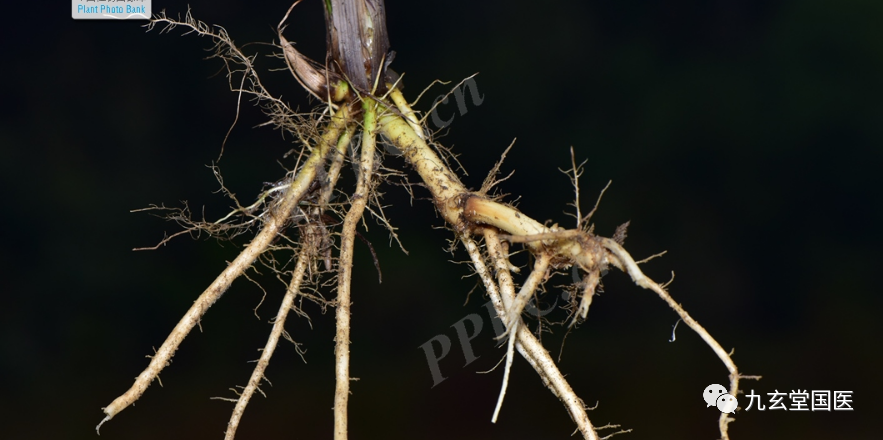
Harvesting:Harvest in autumn, wash, and dry.
Cultivation:In February and March, the roots grow naturally, with leaves resembling emerging bamboo. In May and June, stems grow and bear fruit.
Identification of Characteristics:The roots are slender, cylindrical, or irregularly shaped, with a gray-yellow or gray-brown outer skin, with longitudinal wrinkles and root hair marks. The cross-section is gray-yellow or light brown, with numerous small holes arranged in a ring or ruptured, and the outer skin is easily separable from the inner part. The rhizome is gray-yellow or yellow-brown, with numerous residual roots and stem bases visible on the outer skin. The texture is tough. It has a slight odor and a bland taste.
Pharmacological Effects:Anti-inflammatory effects.
Processing:Take the original medicinal material, remove residual stems and impurities. Wash, slightly moisten, and cut into sections.
Taste and Properties:Bitter and sweet, cold
1.“Dian Nan Ben Cao”: Cold in nature, slightly bitter and sweet in taste.
2.“Gang Mu”: Sweet, slightly cold, non-toxic.
3.“Zhejiang Folk Herbal Medicine”: Cool in nature, bland in taste, non-toxic.
Meridian Entry:“Dian Nan Ben Cao”: Enters the Spleen and Bladder meridians.
Functions and Indications:Has the effects of clearing heat, promoting urination, eliminating dampness, and killing parasites. Commonly used for heat dysuria, blood dysuria, stone dysuria, jaundice, edema, excessive leukorrhea, beriberi, rheumatic pain, and roundworm disease.
Dosage:Internal use: Decoction, 15-30g. External use: Appropriate amount, boiled in water for washing.
Precautions:Prohibited for pregnant women. “Ben Cao Shi Yi”: “Causes miscarriage.”
Various Discussions:
①“Ben Jing”: “Eliminates the three worms.”
②”Bu Que Zhou Hou Fang”: “Treats sudden abdominal fullness and pain, and chest swelling and pain, grind Coix root, boil strongly to extract juice and take.”
③Tao Hongjing: “For children with roundworms, take the root and boil the juice to feed them.”
④”Dian Nan Ben Cao”: “Clears and promotes urination. Treats heat dysuria pain, blood dysuria, stops blood dysuria, and relieves pain in the jade stem, reduces edema.”
⑤”Ben Cao Meng Quan”: “Treats lung abscess.”
⑥”Gang Mu”: “Crush the juice and mix with wine to take, treats jaundice.”
⑦”Cao Mu Bian Fang”: “Can eliminate accumulations and masses, promote urination, and regulate qi and blood. Treats chest fullness and labor injury.”
⑧”Fen Lei Cao Yao Xing”: “Treats hernia.”
⑨”Zhejiang Folk Herbal Medicine”: “Treats excessive leukorrhea.”
Additional Formulas::
①For jaundice like gold: Coix root, decoct and take frequently. (“Gang Mu”)
②For jaundice and dysuria: Five qian to two liang of Coix root. Wash, pound, and extract juice, mix with half a cup of warm red wine, take twice daily. Alternatively, take two liang of root, one liang of yinchen, a little rock candy, and add water to decoct and take three times daily. (“Min Dong Ben Cao”)
③For blood dysuria: Two qian of Coix root, one qian of dandelion, one qian of pig bristle grass, one qian of willow root, boil in water and take with wine. (“Dian Nan Ben Cao”)
④For cloudy dysuria and leukorrhea: Five qian to one liang of Coix root. Boil in water and take. (“Hunan Medicinal Records”)
⑤For roundworm heart pain: One jin of Coix root. Cut, with seven sheng of water, boil down to three sheng, take. (“Mei Shi Ji Yan Fang”)
⑥For rheumatic arthritis: One to two liang of Coix root, boil and take twice daily, or drink frequently as tea.
⑦For spleen and stomach weakness, diarrhea, and indigestion: One to two liang of Coix root. Stew with one pig stomach and take.
⑧For children’s pneumonia, fever, and cough: Three to five qian of Coix root. Boil in soup with honey, take three times daily. (The following formulas from “Min Dong Ben Cao”)
⑨For kidney inflammation, back pain, and painful urination: Urine pearl root, grass root, and sea gold thread. Boil in water and take. (Chengdu “Common Herbal Treatment Manual”)
⑩For toothache: Four liang of Coix root. Boil in water and gargle, change when cold. (“Yan Nian Fang”)
⑾For night blindness: Coix root boiled with rice wash and chicken liver to eat. (“Hunan Medicinal Records”)

